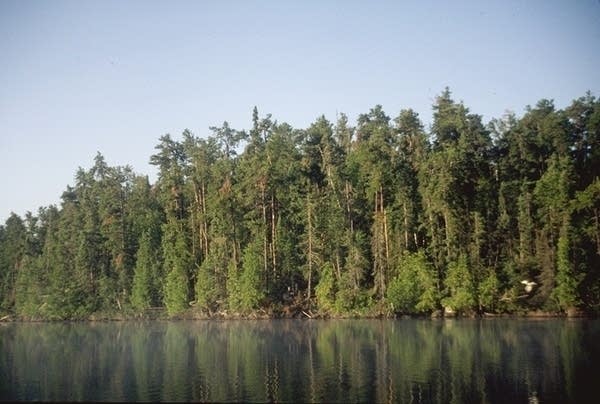Forest changes linked to global warming

Lee Frelich has been studying trees in the Boundary Waters Canoe Area Wilderness for the past 18 years. In that time the University of Minnesota hardwoods researcher says he's witnessed dramatic changes.
"There is a lot more red maple," says Frelich. "And red maple's a species that normally would not be part of the boreal forest in the Boundary Waters. The climate used to be too cold for red maple."

It's not just Minnesota's mild winters that are helping the red maple. Summers are different too. They've been wetter. Frelich says that's kept wildfires in check, giving the red maple a chance to flourish.
But the red maple's gain is a loss for the native northern pines.
Create a More Connected Minnesota
MPR News is your trusted resource for the news you need. With your support, MPR News brings accessible, courageous journalism and authentic conversation to everyone - free of paywalls and barriers. Your gift makes a difference.
"The pines which were historically the species that dominated the forest there are just not reproducing very well and red maple is," says Frelich. "Pines need fire and jack pine in particular is a cold weather species."
These changes are happening quickly, according to Frelich. But that's not unusual along the edges of a biome -- a region characterized by its dominant forms of plant life and climate.
Minnesota has three biomes -- the boreal forest in the north, deciduous forests of oak and maple in the central part of the state, and the prairies and savannahs of southern Minnnesota. Even a small change in a biome's climate can cause a big change in the vegetation.

The way Frelich sees it, Minnesota's climate will continue to warm. The real question is whether it will stay wetter or become drier.
If it's wetter, the woods could end up looking a lot more like Ohio where poplar, sycamore and walnut trees are common. If the climate becomes drier, the forests will retreat and the landscape will look similar to the grassland around Omaha.
That's a sobering prospect for scientists and naturalists. It's also worrisome for people like John Rajala, who makes his living off the forests.
"We're concerned," says Rajala. "But we're not overly concerned with what we're seeing."
Rajala is a fourth generation woodsman based in central Minnesota. His family's business owns 30,000 acres of forest land, most of it in Itasca County.
Rajala says success in the wood products business depends on high quality trees, like white birch, which have been more difficult to find in recent years.
"I'm not a global warming expert so I really can't put 10 years of warmer winters into the broader context. But we do see increased stress on the white birch stands, especially the older ones," says Rajala. "And so then we have to ask ourselves, why is that?"

Rajala says the changes could be due to warmer temperatures. But he thinks there may be other explanations that are just as valid, like the age of the trees. He says many of Minnesota's white birch are quite old and nearing the end of their natural lifespan. He also says people are planting fewer of them, because aspen trees are more valuable these days for paper-making.
It's not just the northern Minnesota timber industry that's noticing the effects of the warmer winters. Southern Minnesota fruit tree growers have also noticed changes.
Ralph Yates, who farms 200 acres of apples near La Crescent in southeastern Minnesota, says the mild weather has brought more unwanted pests to his orchards.
"These populations aren't knocked as heavily as they would be in a traditional Minnesota winter," says Yates.
"So the populations are there in greater numbers in the spring, which means we're gonna have to put greater effort into controlling these pests, greater expense, greater use of crop protection materials," he says.

In other words, more pesticides. Still, Yates isn't sure if this all adds up to global warming.
For its part, the scientific community has become more unified than ever that global warming is occuring.
U of M researcher Lee Frelich says most of his colleagues at the university's Center for Hardwood Ecology believe that Minnesota forests are already changing because of the warmer climate.
He recognizes that for many Minnesotans the forest changes aren't so noticeable. But he predicts it won't be long before they will be hard to miss.
"I'd say if the climate stays as warm as it is now or gets warmer, within 50 years anybody would be able to notice a major change in the Boundary Waters -- with much more oak and maple, a lot less spruce and a lot less pine," says Frelich.
He doubts global warming can be reversed at this point. Frelich says people would have had to stop driving cars 50 years ago to make a difference today. But he does believe there is still time to lessen the effects of global warming by reducing greenhouse gas emissions as much as possible.
